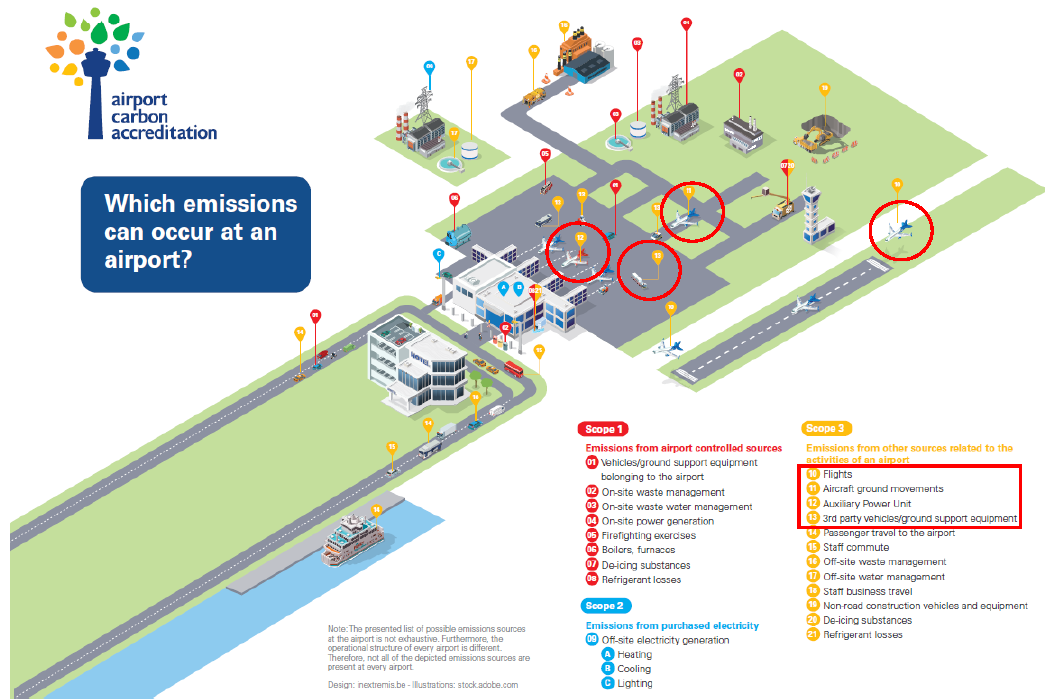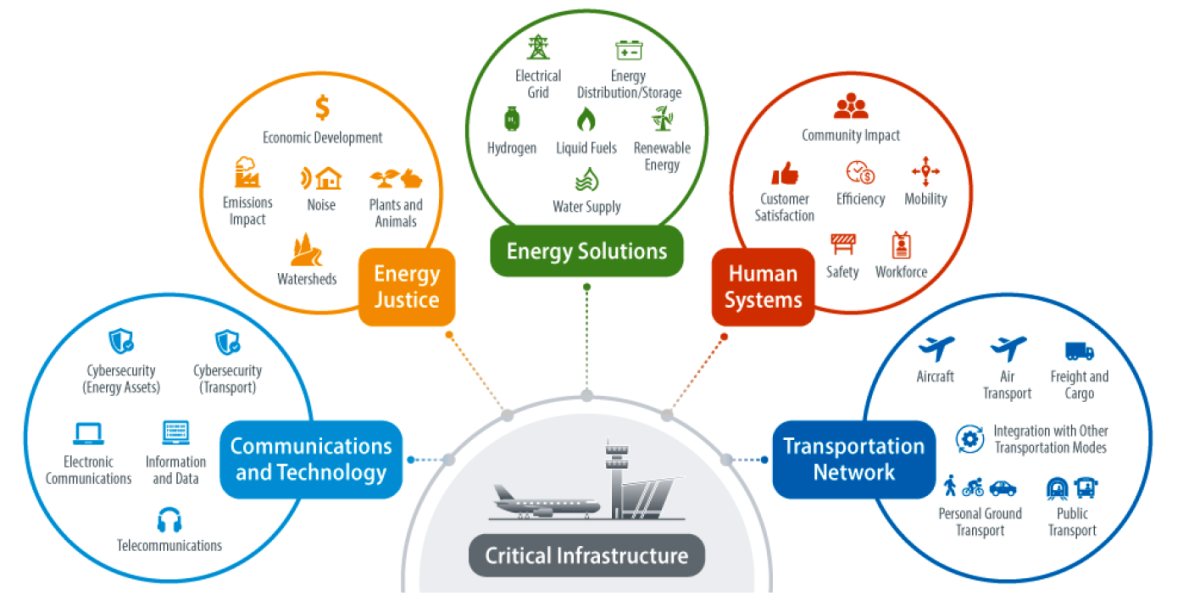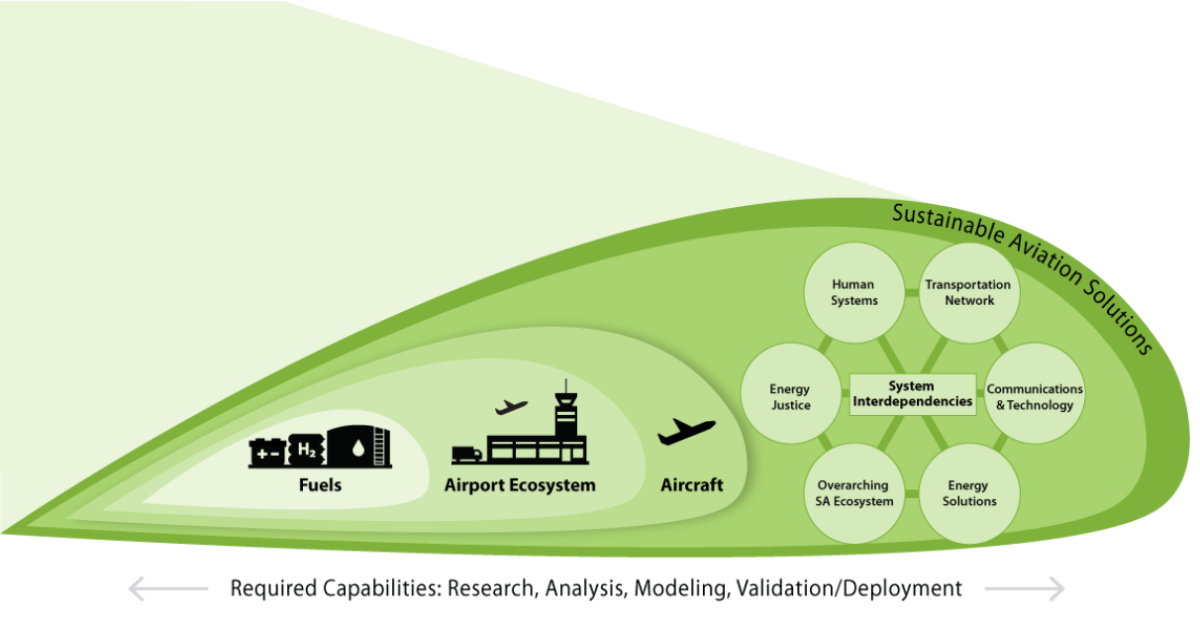AMPLIFY VOL. 36, NO. 5

Around the world, entities of all sizes seek to modernize the aviation industry by optimizing routes, increasing aircraft efficiency, and reducing fossil fuel dependence. The industry is balancing strong passenger and cargo demand, safety, and the need for decarbonization.1 Globally, aviation accounts for about 1 gigaton of greenhouse gas (GHG) emissions per year (approximately 2% of global emissions in 2019) and is poised to increase.2
The industry is committed to achieving decarbonization by continuing energy-efficiency efforts and introducing sustainable fuels and new types of aircraft. Currently, the focus is on fuels for flight operations and, to a lesser extent, low- to zero-emission ground operations.3 Most recently, multiple alternative-propulsion systems and fuels have been proposed, including electrified and hydrogen-fueled aircraft.
Meeting US and international 2050 goals for sustainable aviation fuel (SAF) will require drastic, rapid improvements in carbon reduction and advancements in current technologies or introduction of new ones.4 Deep decarbonization (gradual elimination of carbon-emitting fuels) of the industry is now critical; strong evidence links climate change with increased CO2 levels in the upper atmosphere and other aviation-induced factors.5 CO2 and non-CO2 aircraft emissions exacerbate climate change; impacts vary with the altitude at which they are emitted.6 Non-CO2 impacts from aircraft include nitrogen oxides, contrail cirrus, water vapor, aerosol sulfate, and soot emissions that, combined with CO2, create a positive radiative-forcing effect that causes warming.7
Airports and ground operations contribute about 10% of aviation GHG emissions, often with disproportionate impacts on surrounding lower- and middle-income communities.8 Many airports have committed to decarbonization and transformation of their operations as they prepare to serve a more diverse aircraft portfolio.9 Figure 1 shows the sources of GHG emissions spanning fuels, aircraft, and infrastructure operations.

The complexity and interdependencies required to safely move passengers and goods across transportation modes will continue to increase, generating the need for innovative technologies and integrated solutions. Adding to the complexity is aviation’s extremely high safety standards, global scale, and current market evolution.
Near term, SAF is a priority solution. Meeting industry goals of carbon neutrality requires advancing the state of SAF production, decarbonization, and deployment while advancing new technologies and logistics.
Supporting technologies include alternative energy carriers, propulsion systems, and infrastructure. Alternative energy sources, including hydrogen and electricity, could add benefits such as noise reduction, localized emissions reduction, decreases in ongoing maintenance, and higher viability for autonomous aircraft routes due to the inherent benefit of simpler aircraft systems. New aerial vehicle designs, propulsion requirements, uses, and automation drive complexity while offering new value.
Since its inception at Kitty Hawk, North Carolina, USA, the aviation industry has evolved into a safe, reliable system that continues to improve en route and aircraft efficiency in a complex system that balances safety, economics, available infrastructure, and technology advancements. As major energy users, transportation systems play a key role in many communities, whether from energy transport, noise, emissions, or mobility connectivity.
Deep decarbonization of the aviation sector thus requires contributions from environmental, economic, human, operational, and energy perspectives. Opportunities to improve efficiency and lower emissions can benefit from a holistic view that strengthens existing initiatives — potentially unlocking unforeseen opportunities and overcoming constraints.
Focusing on any one set or even related sets of systems for transformation in the aviation industry addresses only part of the challenge. As aviation operations diversify to include electrified options, hydrogen, SAF, and other low-carbon fuels, the interdependencies between support systems will require holistic assessments and multiple solution sets to achieve full decarbonization.
Integrated system analyses can lead to well-coordinated approaches prior to implementation. The ability to develop and de-risk solutions for global implementation will allow impacted stakeholders (e.g., regulatory agencies, airport authorities, manufacturers, cities/towns, financial institutions, the public) to choose implementation pathways at an appropriate pace and scale.
Understanding the Aviation Ecosystem
Figure 2 shows the interdependencies across the aviation industry. Each set of systems (communications/technology, energy justice, energy solutions, human systems, and transportation networks) comprises multiple subsystems, highlighting the degree of connectivity in this industry and thus the need to approach solutions holistically. Each subsystem influences other subsystems and supports the critical infrastructure of aviation-based operations.

For example, low- and no-carbon solutions have the potential to improve efficiencies, innovate solutions, and address local and global issues, including improving energy justice by influencing jobs, emissions, noise, or other factors. Physical, electrical, and cyber resilience are paramount for communications/technology to support the transportation of fuels, passengers, and goods. Human systems demand the highest safety factors throughout the three pillars of fuels, airport ecosystems, and aircraft while recognizing related needs of the transportation market driven by customer experience, accessibility to transportation, and community impact of established or emerging transportation amenities.
Transforming the Aviation Ecosystem
Decarbonizing the aviation industry will require steady, transformational growth. Efforts are already underway and growing, with commitments from industry coalitions such as the US Federal Aviation Administration (FAA), International Civil Aviation Organization (ICAO), International Air Transport Association (IATA), and others to reduce CO2, other emissions, and environmental impacts.
For example, ICAO’s global coalition for sustainable aviation includes companies like Airbus and Archer that are pursuing zero-emission aircraft and universities like Cranfield University, UK, and the Eindhoven University of Technology, the Netherlands, that are researching novel fuels.10 The coalition includes 47 partners dedicated to sustainable aviation.
Major efforts are focused on SAF, and leading airports are evaluating ways to both modernize and decarbonize, targeting net-zero operations by 2050 or sooner.11 To meet these goals and create financially viable low-carbon solutions at unprecedented speed and scale, public and private stakeholders have expressed the need to collaborate. They recognize that new approaches will be needed to bring these solutions to fruition, including a coordinated research, development, demonstration, and deployment (RDD&D) focus.
Figure 3 shows the three major pillars of the aviation ecosystem: energy carriers (fuels), airport ecosystems, and aircraft. Categorizing the numerous interconnections, subsystems, and energy-related influences is key to ensuring prioritization of the largest, most influential decarbonization pathways while minimizing unintended consequences to adjacent activities and communities.

SAF
Traditionally, aviation fuels have been petroleum-derived liquids that are delivered to airport storage facilities. Decarbonized solutions for future fuels include SAFs (including electrofuels, aka “e-fuels”), hydrogen, and electricity.12 Each alternative has challenges related to production, distribution, and storage.
SAF requires multilayered development and validation along the feedstock supply (e.g., cooking oil), pretreatment, intermediate stream production, technology validation, refiner, distribution, and customer value chain. Numerous feedstock pathways must be scaled up to address the global use of local resources and the volume required to meet global demand. Turning feedstocks into liquid fuel requires physical collection, contaminant processing, and chemical manipulation, so refiners need significant technical, environmental, and economic reassurances to successfully scale up operations.
Streamlined ASTM certification processes and other initiatives have contributed to significant airline offtake agreements and the US federal government’s SAF Grand Challenge, which aims to have 35 billion gallons of SAF in place in the US by 2050.13 Companion efforts by the FAA focus on improving aircraft efficiency and quantifying various elements to reduce emissions and increase aircraft operations efficiency under programs such as Continuous Lower Energy, Emissions, and Noise (CLEEN)14 and ASCENT (Aviation Sustainability Center).15
Despite numerous challenges, SAFs have the potential to decrease carbon emissions from air travel. SAF is simpler and faster to implement than other solutions, giving experts time to develop zero-emission solutions for the long term. Because SAFs still emit GHGs (and global aviation fuel use is on track to double from 106 billion gallons in 2019 to 230 billion gallons in 2050), more carbon-neutral forms of SAF should be a part of the solution to decarbonize aviation.16
Hydrogen-Based Fuels
Hydrogen gives aviators the ability to refuel at rates equivalent to fossil fuels. It may also lower engine-noise levels; reduce or eliminate carbon emissions; and leverage infrastructure across ground, marine, and air transportation and industrial networks.17
Hydrogen refueling rates are comparable to Jet A refueling rates, with the National Renewable Energy Laboratory (NREL) recently making significant progress on rapid delivery to vehicles. In April 2022, NREL demonstrated an average mass flow rate of 14 kg/min (21-kg/min peak), similar to those used by heavy-duty vehicles. A kilogram of hydrogen has approximately the same amount of energy as a gallon of jet fuel. Pairing localized renewable energy generation with hydrogen can lead to energy-storage and grid-stabilization capabilities that support transportation needs.
Distance traveled depends on decreasing weight within the system; currently, hydrogen offers longer distances than battery-fueled electric aircraft. However, the technology needs improvements to reach the operational capabilities of traditional fossil fuels due to hydrogen’s lower volumetric energy density in both gaseous and liquid form.18 Estimates show that hydrogen combustion could reduce aviation’s climate impact to a degree similar to SAFs.19
Hydrogen economics, infrastructure, and storage on the aircraft present significant challenges for the two pathways currently under development: direct combustion and hydrogen fuel cell–generated electricity. Efforts are underway to mitigate these issues. Airbus announced that hydrogen-fueled propulsion systems would be at the heart of a new generation of zero-emissions commercial aircraft.20 The first is a turboprop-driven aircraft capable of carrying around 100 passengers about 1,000 nautical miles. United Airlines and Alaska Airlines have announced investments in hydrogen-based aircraft with ZeroAvia for the type of 70-seat aircraft pervasive in regional travel.21 In 2012, the US Army launched 16 fleet vehicles powered by hydrogen fuel cells in the US state of Hawaii, fueled by hydrogen stations on Oahu, Hawaii.22
The cost of hydrogen is high compared to other sustainable energy sources. To address that challenge, in June 2021, the US Department of Energy announced the Hydrogen Shot initiative, which aims to reduce the price of 1 kg of hydrogen to US $1 in one decade.23 Another key challenge involves the emissions intensity of current hydrogen fuel production. The most economic method uses steam methane reforming of natural gas. For hydrogen to be an effective contributor to the decarbonization of the aviation industry, whether as a direct energy carrier or a feedstock for liquid fuels, production processes like clean electrolyzers and carbon-capture technologies must become more cost-effective.
Electric Flight
Electrified propulsion provides a significant opportunity to decarbonize travel for trips under 500 miles, but there are a range of emerging technologies and propulsion types. Electric vertical takeoff and landing (eVTOL), alternative-propulsion conventional takeoff and landing, and larger short-haul aircraft are being pursued by various commercial ventures. Potential benefits include reduced noise, maintenance, and emissions; use of existing energy infrastructure (although improvements may be necessary); and opportunities for local electrical generation and storage.
At least seven manufacturers are in the FAA-certification process. Several others are actively developing propulsion systems, forming airline partnerships, and seeking certification through ICAO-approved pathways. Multiple manufacturers have completed test flights, and initial deployments have begun in flight-training operations and short-distance seaplane services using retrofitted aircraft. Benefits such as efficiency gains, lower operating costs, and the potential to use existing general aviation airports (or expanded vertiport locations) make this technology appealing to underserved markets and subsidized routes such as the US federal Essential Air Service market.
It will take years before this approach achieves mass certification, builds the necessary support infrastructure, and gains passenger confidence. Nonetheless, battery electric vertical takeoff and landing capabilities were more established than hydrogen options as of 2022, based on aircraft known to be in the FAA-certification process. This is particularly the case with the general aviation sector, which accounts for more than 90% of registered civil aircraft in the US and where shorter-haul flights are more common.24
Conclusion
Proper assessment of aviation decarbonization opportunities will require research on: (1) interdependencies with other industries and (2) their social, economic, and environmental impacts. These include energy generation, transmission and distribution planning, ground transportation and other intermodal logistics, industrial and manufacturing needs, community energy and transportation planning from rural to urban locations, autonomous energy systems to facilitate incorporation of grid edge technology, and energy/environmental justice.
Multiple US federal agencies are addressing components of this system while seeking additional collaboration aimed at decarbonizing aviation at a system level in a resilient, sustainable manner. Industry, federal, and state collaborations are necessary for the aviation industry and related interdependent systems to reach their decarbonization goal. Such a holistic approach would highlight other benefits of the global aviation ecosystem moving toward decarbonization:
-
Mobility options are anticipated to accelerate with the commercialization of electric and hydrogen-based aviation. Rapid intercity-to-regional transportation, point-to-point, or rural-to-urban flight options may offer better coordination for intermodal connections and provide new, lower-cost options for commerce.
-
Emission, contrails, and other environmental pollutants will be reduced should greater volumes of decarbonized fuels integrate into the aviation industry.
-
Cyber measures leveraged from energy-sector efforts are available to increase the security and safety of new aviation options.
-
As more airports adopt onsite renewable electricity generation and energy storage, resilience of the energy supply and ability to meet demand may offer enhanced benefits for both aviation and local community energy needs.
-
Carbon-negative SAFs or e-fuels would assist with environmental efforts.
-
Lower-cost mobility and freight/package delivery costs could provide an economic boom to the US and the world.
The decarbonization challenge is formidable. Airports, bases, and vertiports are complex, interdependent systems that are rapidly changing in their energy types, use cases, and demand models. However, advanced research and analysis on an aircraft’s energy components such as batteries, power electronics, and hydrogen components (including fuel tank and material composites) could accelerate new mobility applications, and holistic RDD&D could maximize impact and accelerate decarbonization across the industry.
This is an excerpt of a larger technical report from the National Renewable Energy Laboratory (NREL). Access the full report or visit the NREL website to explore ongoing sustainable aviation research.
This work was authored by NREL, operated by the Alliance for Sustainable Energy, LLC, for the US Department of Energy (DOE) under Contract No. DE-AC36-08GO28308. The views expressed in the article do not necessarily represent the views of the DOE or the US government. The publisher, by accepting the article for publication, acknowledges that the US government retains a nonexclusive, paid-up, irrevocable, worldwide license to publish or reproduce the published form of this work, or allow others to do so, for US government purposes.
References
1 Teter, Jacob, et al. “Aviation.” International Energy Agency (IEA), September 2022.
2 Bouckaert, Stéphanie, et al. “Net Zero by 2050: A Roadmap for the Global Energy Sector.” International Energy Agency (IEA), May 2021.
3 Teter et al. (see 1).
4 Teter et al. (see 1).
5 Grobler, Carla, et al. “Marginal Climate and Air Quality Costs of Aviation Emissions.” Environmental Research Letters, Vol. 14, No. 11, November 2019.
6 Matthes, Sigrun, et al. “Mitigation of Non-CO2 Aviation’s Climate Impact by Changing Cruise Altitudes.” Aerospace, Vol. 8, No. 2, January 2021.
7 Grobler et al. (see 5).
8 Wolfe, Philip J., et al. “Near-Airport Distribution of the Environmental Costs of Aviation.” Transport Policy, Vol. 34, July 2014.
9 Greer, Fiona, Jasenka Rakas, and Arpad Horvath. “Airports and Environmental Sustainability: A Comprehensive Review.” Environmental Research Letters, Vol. 15, No. 10, October 2020.
10 “ICAO Partners on the Global Coalition for Sustainable Aviation.” International Civil Aviation Organization (ICAO), accessed May 2023.
11 Teter et al. (see 1).
12 E-fuels are low-carbon or carbon-neutral fuels containing hydrogen and CO2 produced using electricity and a carbon source; see: Ramirez, Adrian, S. Mani Sarathy, and Jorge Gascon. “CO2 Derived E-Fuels: Research Trends, Misconceptions, and Future Directions.” Trends in Chemistry, Vol. 2, No. 9, September 2020.
13 “Sustainable Aviation Fuel Grand Challenge.” Biomass Research & Development (BR&D), accessed May 2022.
14 “Continuous Lower Energy, Emissions, and Noise (CLEEN) Program.” US Federal Aviation Administration (FAA), accessed May 2023.
15 “Project by Topic.” The Aviation Sustainability Center (ASCENT), accessed May 2023.
16 Holladay, Johnathan, Zia Abdullah, and Joshua Heyne. “Sustainable Aviation Fuel: Review of Technical Pathways.” US Department of Energy, Office of Scientific and Technical Information, 9 September 2020.
17 Fuel Cells and Hydrogen 2 Joint Undertaking. “Hydrogen-Powered Aviation: A Fact-Based Study of Hydrogen Technology, Economics, and Climate Impact by 2050.” Publications Office of the European Union, 2020.
18 Sharpe, Jessica E., et al. “Modelling the Potential of Adsorbed Hydrogen for Use in Aviation.” Microporous and Mesoporous Materials, Vol. 209, June 2015.
19 Fuel Cells and Hydrogen 2 Joint Undertaking (see 17).
20 “The ZEROe Demonstrator Has Arrived.” Airbus, 22 February 2022.
21 “Alaska Airlines and ZeroAvia Developing World's Largest Zero-Emission Aircraft.” Press release, Cision PR Newswire, 1 May 2023.
22 Garland, Nancy L., Dimitrios C. Papageorgopoulos, and Joseph M. Stanford. “Hydrogen and Fuel Cell Technology: Progress, Challenges, and Future Directions.” Energy Procedia, Vol. 28, 2012.
23 Hydrogen and Fuel Cell Technologies Office. “Hydrogen Shot.” US Department of Energy, Office of Energy Efficiency & Renewable Energy, accessed May 2022.
24 “State of General Aviation 2019.” Aircraft Owners and Pilots Association (AOPA), accessed May 2023.
©2023 Alliance for Sustainable Energy, LLC. All rights reserved.













